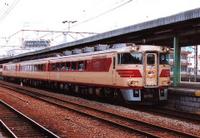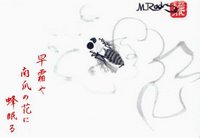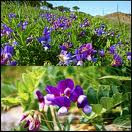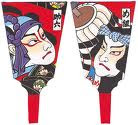:::::::::::::::::::::::::::::::::::::::::::::::::::::::::::::::::::::::::::::::::::::::::::::::::::::
fugu 河豚 / 鰒 / 鯸 / 魨 blowfish, puffer fish
***** Location: Japan
***** Season: Various, see below
***** Category: Animal
*****************************
Explanation
河豚、the pig of the sea, as the kanji may be interpreted.
kigo for all winter
Fugu, Spheroides and Tetraodontiformes family. puffer fish Kugelfisch
The fish is about 30 cm long, the mouth quite small and the belly can be blown up in case of need, to make the animal look much bigger. The poison in his liver is deadly, otherwise it is a delicacy. The ovaraies (fugu no ko) are especially valued. Dried and blown up, he makes a lovely (?) souvenir of Western Japan and Kyushu, where he is most delicate.
Gabi Greve

buying a stamp -
even at the post office
I meet my fugu
.................................................................................
many kigo with the blowfish
fugu choochin 河豚提燈(ふぐちょうちん)fugu as a lampion decoration
see photo below
fugu 河豚 (ふぐ) / 鰒(ふぐ)
blowfish, pufferfish, puffer, globefish, swellfish
mafugu 真河豚(まふぐ)Takifugu porphyreus
namerafugu 滑河豚(なめらふぐ)fam. Tetraodontidae
torafugu 虎河豚(とらふぐ)"tiger fugu", Takifugu rubripes
akame fugu 赤目河豚(あかめふぐ)"fugu with read eyes"
Takifugu chrysops
komon fugu 小紋河豚(こもんふぐ)"fugu with small patterns"
Takifugu poecilonotus
goma fugu 胡麻河豚(ごまふぐ)"fugu with sesame seed pattern"
Takifugu stictonotus
kita makura, kitamakura 北枕(きたまくら) "pillow in the north"
Canthigaster rivulata
(kitamakura is used as a pillow facing north, only for placing a dead body.)
Pillow (makura) and haiku
harisenbon, hari senbon 針千本(はりせんぼん)
"one thousand needles". Balloon porcupinefish
Diodon holocanthus
sabafugu, saba fugu 鯖河豚(さばふぐ)"mackerel fugu"
Lagocephalus wheeleri
ginga fugu 銀河河豚(ぎんがふぐ)"galaxy fugu"
kusa fugu, kusafugu 草河豚(くさふぐ)"plant fugu"
Takifugu niphobles
ginfugu 金河豚(きんふぐ)"golden fugu"
Auriglobus modestus
hakofugu, hako fugu 箱河豚(はこふぐ)
Ostracion immaculatus
oman fugu 巾著河豚(おまんふぐ)Kinchaku fugu
umi suzume 海雀(うみすずめ)"sparrow of the sea"
Lactoria diaphana
itomaki fugu 糸巻河豚(いとまきふぐ)"reel fugu"
Kentrocapros aculeatus
.................................................................................
humanity kigo for all winter
fugunabe, fugu nabe blowfish stew 河豚鍋(ふぐなべ)
fugujiru, fugu jiru 河豚汁 (ふぐじる) blowfish soup
fugutojiru ふぐと汁(ふぐとじる)、fugutoojiru ふぐとう汁(ふぐとうじる)
..... fuku ふく, fukuto ふくと, fukube ふくべ
fukujiru 河豚汁
other famous fugu dishes as kigo
fuguchiri 河豚ちり(ふぐちり)
tetchiri てっちり
fugu meat in boiling water
. . . CLICK here for Photos !
hirezake 鰭酒(ひれざけ)
ricewine with soaked blowfish fins

teppoonabe 鉄砲鍋(てっぽうなべ)"gun hodgepodge"
Some kind of russian roulette when eating this poisonous fish together with a friend.
fugu no yado 河豚の宿(ふぐのやど)
restaurant that serves fugunabe
fugu no tomo 河豚の友(ふぐのとも)
friend to eat blowfish with
fugu no doku 河豚の毒(ふぐのどく)blowfish poison
fugu atari 河豚中り(ふぐあたり)blowfish poison poisoning
It was quite deadly in the Edo period.
fugu tsuri 河豚釣(ふぐつり)fishing for fugu
fugu ami 河豚網(ふぐあみ) net for fishing fugu
observance kigo for mid-spring
. Fugu Kuyoo 河豚供養 Memorial Service for Pufferfish .
At the end of the Fugu season
April 29. Especially in Shimonoseki at Haedodomari 南風泊
Small torafugu baby tiger pufferfish are let to swim in the sea.
:::::::::::::::::::::::::::::::::::::::::::::::::::::::::::::::::::::::::::::::::::
Blowfish as a lamp, with a thousand needles
(hari senbon はりせんぼん)
http://www.geocities.co.jp/HeartLand-Himawari/5315/fugu.htm
:::::::::::::::::::::::::::::::::::::::::::::::::::::::::::::::::::::::::::::::::::::::::::::::::::::
Fugu Sashimi, a delicacy
http://www.rakuten.co.jp/uokatsu/590013/#569379
Is the evil blowfish - also known as puffer, globefish, or swellfish - in danger of extinction?
In Japan, eating the honorable fugu (blowfish) is the ideal of gourmet dining-and the
cooking version of Russian roulette. According to Japan Economic newswire, a Japanese wholesaler exported the first 90 kg of vacuum-packed fugu to Hong Kong in October 1995. Hong Kong is the second market to import fugu from Japan. New York, which started importing the fish in 1989, currently sells about 1 tons of fugu every year, according to the wholesaler. Fugu's trade volume is rising because of people's curiosity in eating such fish.
In Japan, eating fugu has been the gastronomic version of Russian roulette for centuries. "His chopsticks roll to the table from nerveless fingers; he pales; his breathing labors." Dining on fugu
is often the subject of traditional senryuverse.
Last night he and I ate fugu;
Today I help carry his coffin.
"It's a terrible death," a Japanese cook said. "Although you can think clearly, you cannot speak or move and soon cannot breathe."
Why the Japanese should make a ritual eating deadly poisonous fish is difficult for foreigners to comprehend. For many the elegant, death-defying event is a status symbol, and disciples say that consumption of the meat produces a pleasant, warm tingling.
Nonetheless, fugu ovaries, intestines and livers can be so deadly that if even touch of them is left in the fish, the diner dies, sometimes in minutes.
In the medieval era, the Tokugawa shogunate regime strictly banned blowfish consumption. But it became popular again around the end of the regime in the mid-19th century as the government lost control over the people. Kiichi Kitahara, the owner of Blowfish museum in Osaka, noted as follows: "Human beings are funny. They want to eat what is forbidden. The history of blowfish is the history of prohibition by authorities. If blowfish weren't poisonous, they might not be so popular."
Read a lot more interesting information about the fugu.
http://www.american.edu/projects/mandala/TED/blowfish.htm
:::::::::::::::::::::::::::::::::::::::::::::::::::::::::::::::::::::::::::::::::::::::::::::::::::::
Japanese Link about the Fugu

. トラフグ Torafugu, the Tiger Blowfish
http://homepage3.nifty.com/shokubun/fugu1.html
Onsen Torafugu 温泉トラフグ grown in a hot spring
. . . CLICK here for Photos !
In Tochigi, the mountain community Nakagawa Machi 那珂川町 is growing torafugu in the salty water of a local onsen, in large basins at an abandoned school. Before preparing them as food, they are put in a special container with high salt percentage, to make them swim faster and later taste better when eaten, (ajiage 味上げ).
They also prepare Onsen Torafuju Manju rice cakes with the imprint of a fugu and fugu goods are sold in the village.
:::::::::::::::::::::::::::::::::::::::::::::::::::::::::::::::::::::::::::::::::::::::::::::::::::::
dried blowfish, hoshi fugu 干河豚 (ほしふぐ)
kigo for all summer
..... hoshifugu 乾河豚(ほしふぐ)
"salted blowfish", shio fugu塩河豚(しおふぐ)
sarashiboshi さくら干し(さくらぼし)
noshifuguのし河豚(のしふぐ)
:::::::::::::::::::::::::::::::::::::::::::::::::::::::::::::::::::::::::::::::::::::::::::::::::::::
more
In the Kansai region the slang word teppō, teppoo, (鉄砲) meaning rifle or gun, is used for the fish. This is a play of words on the verb ataru (当たる), which can mean either to be poisoned or to be shot. In Yamaguchi Prefecture, the pronunciation fuku is common instead of fugu. The former means good fortune whereas the latter is a homonym for disabled. The Tsukiji fish market fugu association holds a service each year at the height of the fugu season, releasing hundreds of caught fugu into the Sumida River. A similar ceremony is also held at another large market in Shimonoseki.
A rakugo, or humorous short story, tells of three men that prepared a fugu stew but were unsure as to whether it was safe to eat. To test the stew, they gave some to a beggar. When it did not seem to do him any harm they ate the stew. Later, they met the beggar again and were delighted to see that he was still in good health. After that encounter, the beggar, who had in fact not eaten the stew but hidden it, knew that it was safe and he could eat it. The three men had been fooled by the wise beggar.
© More in the WIKIPEDIA !
Since there was no help against the poison, the fish was also
species of Takifugu, Lagocephalus, or Sphoeroides) or porcupinefish of the genus Diodon.
2 Familien. Fam. Tetraodontidae und Fam Balistoidei .
fugu, akamefugu, mafugu, sangatufugu (Takifugu pardalis)
Wird bis zu 14 Zentimeter lang.
http://www.pref.iwate.jp/~hp5507/h19osakanazukan/page126.htm
shirosabafugu (Lagocephalus wheeleri Abe, Tabeta and Kitahama)
http://www.fishing-forum.org/blog/arara/cat35/cat28/
shoosaifugu (Takifugu snyderi)
http://www.fishing-forum.org/blog/arara/cat35/cat28/
torafugu „Tiger-Kugelfisch“ (Fugu rubripes, tiger blowfish)
Die Eierstöcke können bis zu einem Kilogramm wiegen.
Die Leber und Eierstöcke enthalten das Giftテトロドトキシン tetrodotoxin
http://en.wikipedia.org/wiki/Fugu
In Osaka, there is a special station lunchbox with fugu.
2007年3月19日に "大阪特選ふぐづくし"

In Osaka, Kishiwada, there is a fugu museum. fugu no kan フグの館
Osaka Fugu Hakubutsukan ふぐ博物館
大阪府岸和田市北町10番2号
since Showa 39.
See Comment Below.
*****************************
Worldwide use
*****************************
Things found on the way
The fugu is very popular in Shimonoseki, Japan. An fast train is named after it, the Fugu Express. It looks like a Fugu lampion (fugu choochin 河豚提灯) like in the top picture.

http://nnrf63.hp.infoseek.co.jp/topix20.html
.................................................................................

fugu whistle from Shimonoseki 下関のふぐ笛
..........................................................................

fugu clay bell フグ土鈴 from Enoshima / Kanagawa
. Kanagawa Folk Art - 神奈川県 .
..........................................................................

fugu hime daruma 河豚姫だるま Princess Daruma with Fugu design
Look at more local dolls from Mojigaseki gallery in Fukuoka :
source : mojigaseki gallery
. Fukuoka Folk Art - 福岡県 - Daruma Muesum .
fugu soup -
I find some Daruma
while I slurp
Gabi Greve
fugu daruma 河豚だるま blowfish Daruma
a pun with FUKU

..........................................................................
MORE
. Folk Toys from Yamaguchi / Shimonoseki .
*****************************
HAIKU

source : wakizaka san
あら何ともなや昨日は過ぎて河豚汁
ara nani tomo ya kinoo wa sugite fukutojiru
1677
. Matsuo Basho - Archives of the WKD .
well, nothing happened -
even though yesterday I ate
fugu soup
Tr. Addiss
oh, nothing's happened to me!
yesterday has passed--
fugu soup
Tr. Ueda
well--nothing's happened
and yesterday's come and gone!
blowfish soup
Tr. Barnhill
well nothing happened
yesterday has passed away
with globefish soup
Tr. Reichhold
well, nothing happened -
and yesterday's come and gone!
blowfish soup
fugu soup
Tr. Gabor Terebess
quote
Oh, without any incident
yesterday has passed--
a globefish soup party
Of course, safely cooking globefish needs a professional technique even in our days, because otherwise the diner risks illness and even death. Basho’s haiku informs us that people of his day could take pleasure in gastronomic delights such as globefish, at the risk of their life. It speaks of peaceful urban life which allowed the temptation for danger, such was the degree of security of the time.
source : Ban’ya Natsuishi
:::::::::::::::::::::::::::::::::::::::::::::::::::::::::::::::::::::::::::::::::::::::::::::::::::::::
親分と家向あふて鰒と汁
oyabun to ie muki-oute fukuto-jiru
across the street
a godfather's house --
blowfish chowder
Tr. Chris Drake
Read more about the Oyabun/Kobun group relations and
. Kobayashi Issa and the Fugu Soup .
:::::::::::::::::::::::::::::::::::::::::::::::::::::::::::::::::::::::::::::::::::::::::::::::::::::::
逢(あは)ぬ恋おもひ切ル夜やふくと汁
awanu koi omoikiruyo ya fukutojiru
Unrequited love
He has decided to give up
On that night - fugu soup!
Tr. Shoji Kumano
I cannot see her tonight.
I have to give her up
So I will eat fugu.
Tr. in wikipedia
fugujiru no ware ikite iru nezame kana
Fugu soup;
I awoke
And found myself alive!
Tr. Shoji Kumano
fugujiru no teishu to miete jooza kana
At a fugu soup table
He must be the host,
Sitting at the head.
- Tr. Shoji Kumano
. Yosa Buson 与謝蕪村 in Edo .
..........................................................................
fugu soup;
even my chopsticks
hesitate
source : Don Baird - Buson Study Group
:::::::::::::::::::::::::::::::::::::::::::::::::::::::::::::::::::::::::::::::::::::::::::::::::::::::
chrysanthemum:
the last-ing taste of
blowfish flesh
Chibi
Look at the dish here:
http://worldkigodatabase.blogspot.com/2005/03/chrysanthemum-kiku.html
xxxxxxxxxxxxxxxxxxxxxxxxxxxxxx
河豚喰えば佛も我もなかりけり
fugu kueba hotoke mo ware mo nakarikeri
eating blowfish
being a Buddha, being myself
who cares ?
(Free translation by Gabi Greve.
Hotoke can mean a Buddha and is also used for the corpse of a dead person.)
http://www.shiomura.com/shiori.html
http://plaza.harmonix.ne.jp/~mitsue-o/html/k-what.htm
:::::::::::::::::::::::::::::::::::::::::::::::::::::::::::::::::::::::::::::::::::::::::::::::::::::

キタマクラばかり釣り上げ波止残暑
kitamakura bakari tsuriage hato zansho
all I fish out
is deadly blowfish -
remaining heat on the pier
Hashimoto Mariko 橋本まり子
. susami town haiku, 2004
*****************************
Related words
***** WINTER FOOD with Blowfish
:::::::::::::::::::::::::::::::::::::::::::::::::::::::::::::::::::::::::::::::::::::::::::::::::::::
WASHOKU ... Japanese Food SAIJIKI
. ANIMALS in all SEASONS
SAIJIKI
:::::::::::::::::::::::::::::::::::::::::::::::::::::::::::::::::::::::::::::::::::::::::::::::::::::










































